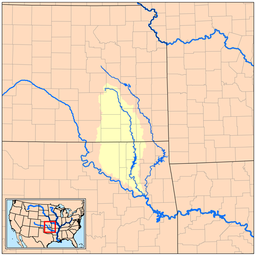Verdigris River
| Verdigris River | |
| Van Horner Creek, Vermillion River, Wasetihoge River | |
|
The Verdigris River near Lenapah, Oklahoma
|
|
| Country | United States |
|---|---|
| State | Kansas, Oklahoma |
| Tributaries | |
| - right | Fall River, Elk River, Caney River |
| Source confluence | |
| - location | Madison, Kansas |
| - elevation | 1,090 ft (332 m) |
| - coordinates | 38°09′08″N 96°10′01″W / 38.15222°N 96.16694°W |
| Mouth | Arkansas River |
| - location | Muskogee, Oklahoma |
| - elevation | 489 ft (149 m) |
| - coordinates | 35°48′01″N 95°18′28″W / 35.80028°N 95.30778°WCoordinates: 35°48′01″N 95°18′28″W / 35.80028°N 95.30778°W |
| Length | 310 mi (499 km) |
| Discharge | for USGS 07176000 near Claremore, OK |
| - average | 4,644 cu ft/s (132 m3/s) |
| - max | 77,700 cu ft/s (2,200 m3/s) |
| - min | 3.4 cu ft/s (0 m3/s) |
| Watersheds | Verdigris-Arkansas- Mississippi |
| Reservoirs | Toronto Lake, Oologah Lake |
|
Map of the Verdigris watershed
|
|
The Verdigris River /ˈvɜːrdᵻɡrɪs/ is a tributary of the Arkansas River in southeastern Kansas and northeastern Oklahoma in the United States. It is about 310 miles (500 km) long. Via the Arkansas, it is part of the Mississippi River watershed.
The Verdigris is formed near Madison, Kansas, by the convergence of two short headwaters streams, its North and South forks, and flows generally southward throughout its course. South of Coffeyville, Kansas, the river enters Oklahoma. It joins the Arkansas River near Muskogee, Oklahoma, about a mile upstream of the mouth of the Neosho River. The area of convergence of the three rivers Arkansas, Verdigris and Neosho is called "Three Forks".
The river is mentioned in accounts by Zebulon Pike (1806), Thomas Nuttall (1818). Fur traders had numerous posts along its route where they met with Native Americans to exchange goods for furs. The river is also mentioned in the novel Little House on the Prairie (1935) by Laura Ingalls Wilder, of her memories when her family moved to Kansas from Wisconsin.
The name is derived from the Spanish words verde, meaning "green," and gris, meaning "grey." According to the Encyclopædia Britannica, the name may be derived from a gray-green substance resembling a copper ore, which tinged the water. In the US treaty of 1834 with the Cherokee Indians, the river was named as a part of the boundary of their lands in the Indian Territory.
...
Wikipedia


